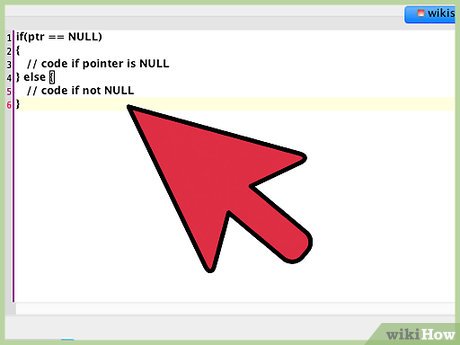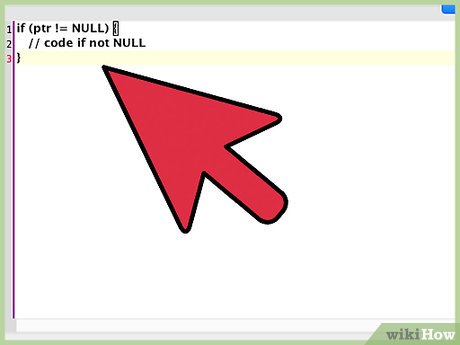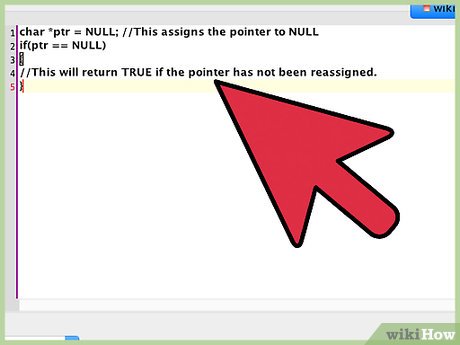How to Check Null in C
Part 1 of 2:
Performing a Null Check
-
 Use the standard null check code. The following is the most obvious way to write a null check. We'll use ptr in this article as the name of the pointer you're checking.
Use the standard null check code. The following is the most obvious way to write a null check. We'll use ptr in this article as the name of the pointer you're checking.- if(ptr == NULL)
{
// code if pointer is NULL
} else {
// code if not NULL
}
- if(ptr == NULL)
-
 Test for any value but NULL. Sometimes it's more convenient to test for inequality instead. No surprises here:
Test for any value but NULL. Sometimes it's more convenient to test for inequality instead. No surprises here:- if (ptr != NULL) {
// code if not NULL
}
- if (ptr != NULL) {
-
 Write the NULL first to avoid errors (optional). The main disadvantage to the PTR == NULL method is the chance that you'll accidentally type ptr = NULL instead, assigning the NULL value to that pointer. This can cause a major headache. Since testing for (in)equality treats the operands symmetrically, you can get exactly the same result by writing if (NULL == ptr) instead. This is more typo-resistant, since an accidental NULL = ptr creates a simple compile error.
Write the NULL first to avoid errors (optional). The main disadvantage to the PTR == NULL method is the chance that you'll accidentally type ptr = NULL instead, assigning the NULL value to that pointer. This can cause a major headache. Since testing for (in)equality treats the operands symmetrically, you can get exactly the same result by writing if (NULL == ptr) instead. This is more typo-resistant, since an accidental NULL = ptr creates a simple compile error.- This looks a little awkward to some programmers, but it's perfectly valid. Which approach you use just depends on personal preference, and how good your compiler is at detecting the if (ptr = NULL) error.
-
 Test whether the variable is true. A simple if (ptr) tests whether ptr is TRUE. It will return FALSE if ptr is NULL, or if ptr is 0. The distinction doesn't matter in many cases, but be aware that these are not identical in all architectures.[1]
Test whether the variable is true. A simple if (ptr) tests whether ptr is TRUE. It will return FALSE if ptr is NULL, or if ptr is 0. The distinction doesn't matter in many cases, but be aware that these are not identical in all architectures.[1]- The reverse of this is if (!ptr), which will return TRUE if ptr is FALSE.
Part 2 of 2:
Avoiding Mistakes
-
 Set a pointer before checking for NULL. One common mistake is to assume that a newly created pointer has a NULL value. This is not true. An unassigned pointer still points to a memory address, just not one that you have specified. It's common practice to set newly created or newly freed pointers to NULL to make sure you don't use this unhelpful address by accident.
Set a pointer before checking for NULL. One common mistake is to assume that a newly created pointer has a NULL value. This is not true. An unassigned pointer still points to a memory address, just not one that you have specified. It's common practice to set newly created or newly freed pointers to NULL to make sure you don't use this unhelpful address by accident.- Avoid this mistake:
char *ptr;
if(ptr == NULL)
{
//This will return FALSE. The pointer has been assigned a valid value.
} - Instead write:
char *ptr = NULL; //This assigns the pointer to NULL
if(ptr == NULL)
{
//This will return TRUE if the pointer has not been reassigned.
}
- Avoid this mistake:
-
 Pay attention to functions that could return NULL. If a function can return NULL, think about whether this is a possibility, and whether that would cause problems later in your code. Here's an example of the malloc function using the null check (if (ptr)) to ensure it only handles pointers with valid values:
Pay attention to functions that could return NULL. If a function can return NULL, think about whether this is a possibility, and whether that would cause problems later in your code. Here's an example of the malloc function using the null check (if (ptr)) to ensure it only handles pointers with valid values:- int *ptr = malloc(N * sizeof(int));
if (ptr) {
int i;
for (i = 0; i < N; ++i)
ptr[i] = i;
}
- int *ptr = malloc(N * sizeof(int));
-
 Understand that NULL is 0 but you should always use NULL instead of 0 when working with pointers for clarity. Historically, C represented NULL as the number 0 (that is, 0x00). Nowadays it can get a bit more complicated, and varies by operating system. You can usually check for NULL using ptr == 0, but there are corner cases where this can cause an issue. Perhaps more importantly, using NULL makes it obvious that you are working with pointers for other people reading your code.[2]
Understand that NULL is 0 but you should always use NULL instead of 0 when working with pointers for clarity. Historically, C represented NULL as the number 0 (that is, 0x00). Nowadays it can get a bit more complicated, and varies by operating system. You can usually check for NULL using ptr == 0, but there are corner cases where this can cause an issue. Perhaps more importantly, using NULL makes it obvious that you are working with pointers for other people reading your code.[2]
4 ★ | 2 Vote
You should read it
May be interested
- How to use AI Writing Check to check text generated by AI
 if you have doubts or want to check if something is written with an ai engine, you can use the ai writing check website.
if you have doubts or want to check if something is written with an ai engine, you can use the ai writing check website. - Top 5 Simple and Accurate Ways to Check Computer Mainboard
 checking the computer mainboard is an important step when upgrading hardware to help choose the right components. let's explore the details with hacom here.
checking the computer mainboard is an important step when upgrading hardware to help choose the right components. let's explore the details with hacom here. - 5 ways to check hard drive effectively to help periodically check the hard drive
 the following ways will help you check your hard drive, assess the current status of the hard drive on the computer you are using. since then, there have been early instabilities to find out timely measures to avoid hard drive failure and data loss.
the following ways will help you check your hard drive, assess the current status of the hard drive on the computer you are using. since then, there have been early instabilities to find out timely measures to avoid hard drive failure and data loss. - How to check the code MD5 and SHA1 to check the integrity of the file
 when downloading large files, to check whether the downloaded file is original, whether there is a download error or if the file has been modified before sharing to the user, you need to check the md5 or sha1 code. . so how to check the code md5 and sha1 to check
when downloading large files, to check whether the downloaded file is original, whether there is a download error or if the file has been modified before sharing to the user, you need to check the md5 or sha1 code. . so how to check the code md5 and sha1 to check - 4 best ways to check RAM capacity on Windows 11
 ram is an acronym for random access memory. this is a type of memory installed on the motherboard of a computer to store information.
ram is an acronym for random access memory. this is a type of memory installed on the motherboard of a computer to store information. - How to check hard drive health in 3 ways
 like other computer hardware devices, hard drives also have a certain shelf life. therefore, we need periodic health checks for the hard drive to avoid unfortunate problems that may cause data loss you save in it. please refer to the article below to know how to check the health of computer hard drive offline.
like other computer hardware devices, hard drives also have a certain shelf life. therefore, we need periodic health checks for the hard drive to avoid unfortunate problems that may cause data loss you save in it. please refer to the article below to know how to check the health of computer hard drive offline. - Has your password been leaked? Please check now
 data and password infringement has become a popular part of online life. today, tipsmake.com will introduce to you some ways to help check your password is still safe.
data and password infringement has become a popular part of online life. today, tipsmake.com will introduce to you some ways to help check your password is still safe. - How to check the origin, where iPhone is manufactured through IMEI code, model
 how to check the iphone code, distinguish the origin check of the iphone, ipad on the market to help you choose a good product, limit the wrong purchase of products of unknown origin or unclear origin.
how to check the iphone code, distinguish the origin check of the iphone, ipad on the market to help you choose a good product, limit the wrong purchase of products of unknown origin or unclear origin. - How to check website IP address / domain name
 here are 3 simple and effective ways to easily check your website / domain ip address, you can do it on both computer and phone.
here are 3 simple and effective ways to easily check your website / domain ip address, you can do it on both computer and phone. - How to use KeyboardTest to check the computer keyboard
 keyboardtest is software to check computer keyboards and laptops to see if they work well. especially when buying an old laptop, checking the keyboard is necessary.
keyboardtest is software to check computer keyboards and laptops to see if they work well. especially when buying an old laptop, checking the keyboard is necessary.

















 How to Create a Program in C Sharp
How to Create a Program in C Sharp How to Delay in C
How to Delay in C How to Set Up SDL with Visual Studio
How to Set Up SDL with Visual Studio How to Write Standard Code in C++
How to Write Standard Code in C++ How to Get Color in C Program
How to Get Color in C Program How to Learn to Program in C
How to Learn to Program in C